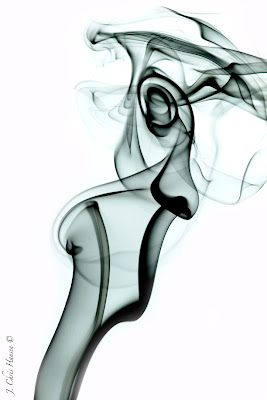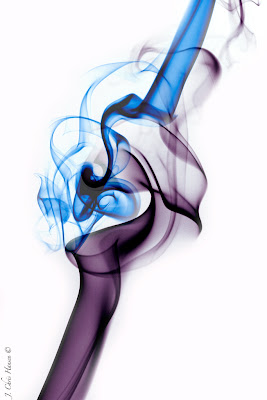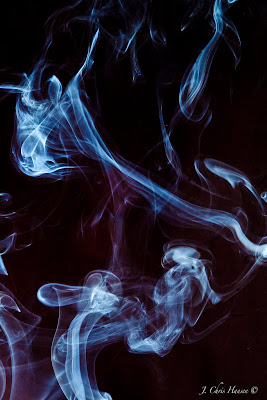
You have probably seen some of those cool images of swirling smoke. If you have a DSLR camera and an external flash, flash cord and some black foamcore you would be surprised how simply it can be done. A basic set up consists of
∆ Flash gun
∆ flash cord
∆ DSLR camera
∆ A black piece of foam core or black tag board roughly 18' x 24" in size
∆ A smaller piece of foamcore or tagboard roughly 8"X10" in size
∆ Incense Stick and holder(or something nonflammable to keep the house from burning down)
∆ A small to medium desk lamp
Work on a kitchen table or a large flat surface in dim light. It doesn't have to be pitch dark.
1. Set the incense stick and holder about a foot from the edge of the table
2. Prop up the large piece of foamcore two feet behind the incense stick and holder
3. One foot to the left of the incense stick set up the desk lamp and aim it at the top of the incense stick.
4. One foot to the right and at a height of about four inches above the incense stick prop up the flash on some books blocks or whatever you have to get it to that height.
5. Light the incense stick and turn on the flash and the desk lamp.
6. Prop up the smaller foamcore piece behind the flash to block light from the background.
7. Hand hold your camera and focus on the tip of the incense stick to help get prefocus.
8. Then use the desk lamp to help you focus on the smoke.
9. Check your histogram after each of your first images to check focus and exposure.



To create a white back ground I do that in post processing in Photoshop.
1. Open up the image in Photoshop. Adjustment- levels. Slide the levels slider slightly to the right to make sure the blacks are solid black.
2.Then create a hue/saturation layer and click the colorize box.
3.Use the hue slider to choose a color for the smoke
4.Bump up the saturation using the slider to about 55.(If you like it that intense)
5.Drop down and click the mask layer and change the opacity to 45 or 50%
6. Now click on the background layer.
7. Go up to Adjustments-invert.
That is all there is to it.
Go out and make some smoke1!
God bless,
chris
 Step two is to use a hole saw to drill a hole into the backside of the wood into the cavity so you can enlarge it. You may have to use a chisel or a sawzall to remove excess material. I used both tools to remove a few small bits.
Step two is to use a hole saw to drill a hole into the backside of the wood into the cavity so you can enlarge it. You may have to use a chisel or a sawzall to remove excess material. I used both tools to remove a few small bits.
 Step three is to use a pair of tin snips to cut vertical strips all away around the top of a tin can. After you have cut the vertical strips use a pair of pliers to fold the strips down ninety degrees to make tabs for securing the can to the wood.
Step three is to use a pair of tin snips to cut vertical strips all away around the top of a tin can. After you have cut the vertical strips use a pair of pliers to fold the strips down ninety degrees to make tabs for securing the can to the wood.
 Step four is to center the can over the hole on the back of the wood. Use some short wood screws to drill through the metal tabs to secure the can to the back of the wood.
Step four is to center the can over the hole on the back of the wood. Use some short wood screws to drill through the metal tabs to secure the can to the back of the wood.
 Step five is to screw a piece of one by three to the feeder to attach it someplace so you can use it for photography.
Step five is to screw a piece of one by three to the feeder to attach it someplace so you can use it for photography.

 Here is a sample image from this morning of a Red Breasted Nuthatch that came to get some black sunflower seed that I poured into it.
Here is a sample image from this morning of a Red Breasted Nuthatch that came to get some black sunflower seed that I poured into it.
 This afternoon I photographed a little bit more with the knothole feeder. Here is a Chestnut Backed Chickadee coming in for some seed.
This afternoon I photographed a little bit more with the knothole feeder. Here is a Chestnut Backed Chickadee coming in for some seed.



























